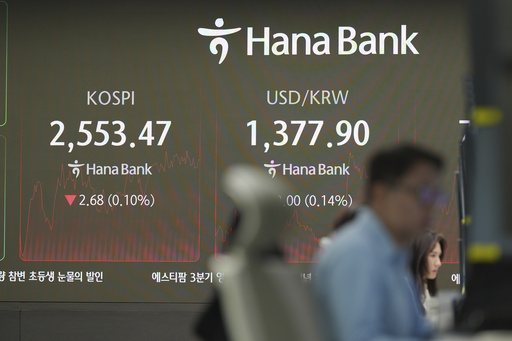Asian stock markets mostly declined on Friday morning, with Japan’s Nikkei index experiencing a drop of over 2% in early trades following a significant slump on Wall Street triggered by high market expectations.
Futures in the United States and oil prices, however, showed signs of improvement.
The Nikkei 225 index in Japan slid by 2.3% to reach 38,196.53. This followed the Bank of Japan’s decision on Thursday to maintain its benchmark interest rate at 0.25%, a move that aligned with what markets anticipated. Consequently, the Japanese yen weakened against the dollar, which rose to 152.35 from the previous 152.00 yen.
In contrast, Chinese markets displayed resilience in an otherwise downcast trading session. The Hang Seng index in Hong Kong advanced by 1.0% to 20,526.69, while the Shanghai Composite index rose by 0.4% to hit 3,294.55.
Significantly, China’s factory activity showed signs of recovery in October. The official purchasing managers’ index (PMI) released on Thursday recorded a score of 50.1, indicating a return to growth after five months of contraction. A separate private survey released on Friday also showed an expansion reading of 50.3.
Australia’s S&P/ASX 200 index fell 0.8% to 8,093.80, reacting to the news that the producer price index for the third quarter had risen by 3.9% year-on-year. This marked a welcome decline back below 4.0% annual growth for the first time since September 2023, as indicated by data from the Australian Bureau of Statistics.
In South Korea, the Kospi index remained nearly stable at 2,556.57, while Taiwan’s Taiex dropped by 0.8%. This decline was affected by a 1% fall in Taiwan Semiconductor Manufacturing Corporation, a key supplier for Apple, following the tech giant’s quarterly earnings report, which highlighted decreasing sales revenue from China.
On Wall Street the previous day, the S&P 500 experienced its largest single-day drop in eight weeks, plummeting 1.9% to close at 5,705.45 and moving further away from its recent all-time high set earlier in October. The Dow Jones Industrial Average decreased by 0.9% to 41,736.46, while the Nasdaq composite saw a notable decline of 2.8%, marking its second consecutive day of losses after reaching a new record high.
Microsoft reported stronger-than-expected profit growth for its latest quarter and exceeded revenue forecasts. However, its share price fell by 6% as investors searched for potential shortcomings. Similarly, Meta Platforms, the parent company of Facebook, provided a positive profit report, but its stock also declined by 4.1%. Investors reacted cautiously to the company’s forecast of substantial spending increases next year in artificial intelligence research.
The significant drop in major technology stocks on the final trading day of October resulted in the S&P 500 erasing its monthly gains. The index fell by 1% over the month, marking its first monthly decline in the last six months, despite achieving an all-time high during that span.
In the bond market, Treasury yields decreased slightly following mixed economic reports in the U.S. One report highlighted a slowdown in a favored inflation measure used by the Federal Reserve, which decreased to 2.1% in September from 2.3%. This result is close to the Fed’s target rate of 2%. However, the underlying trends, excluding food and energy costs, showed inflation pressures that were somewhat higher than economists had anticipated.
Another report indicated that the wage growth rate and benefits for U.S. workers had decelerated over the summer, which could alleviate future inflationary pressures. Additionally, a third report noted a decrease in the number of new unemployment claims, suggesting that layoffs remain relatively low.
Treasury yields fluctuated in response to these reports before trending lower. The yield on the 10-year Treasury dropped from 4.30% to 4.27%, though this remains elevated compared to the approximately 3.60% yield seen in mid-September.
In other trading activities, U.S. benchmark crude oil prices rose by $1.33 to reach $70.59 per barrel. Meanwhile, Brent crude, the international benchmark, increased by $1.23 to $74.04 per barrel.
Additionally, the euro traded down to $1.0878 from $1.0885.



